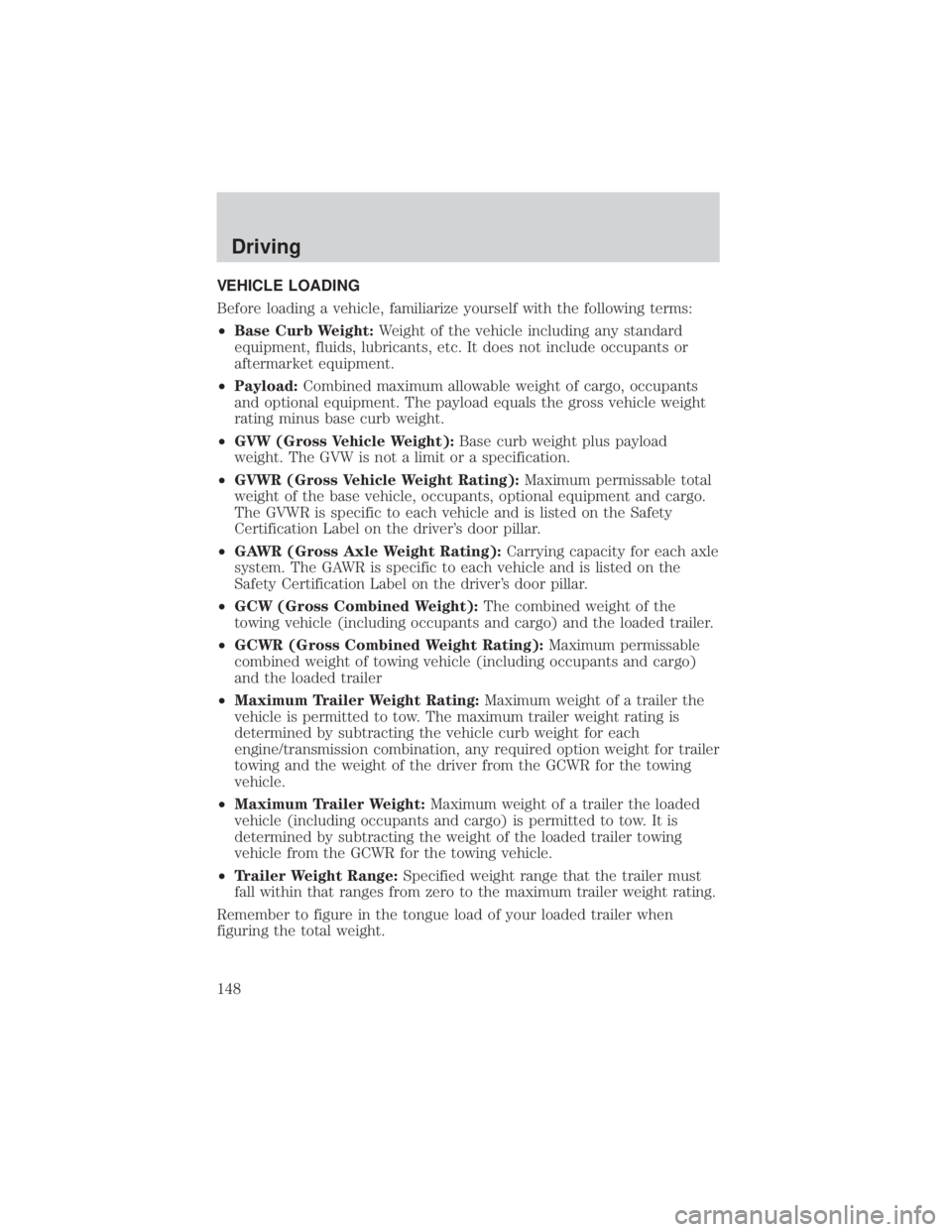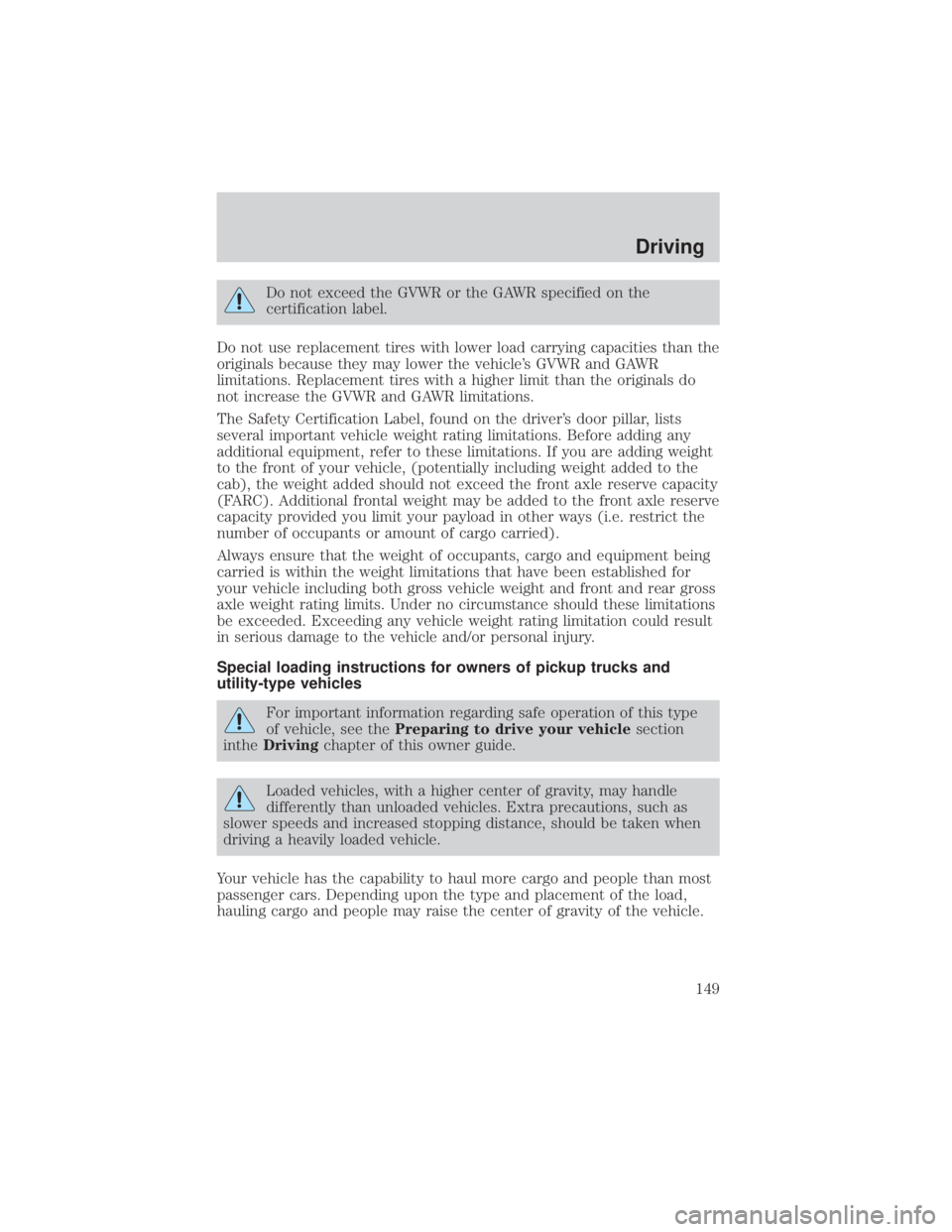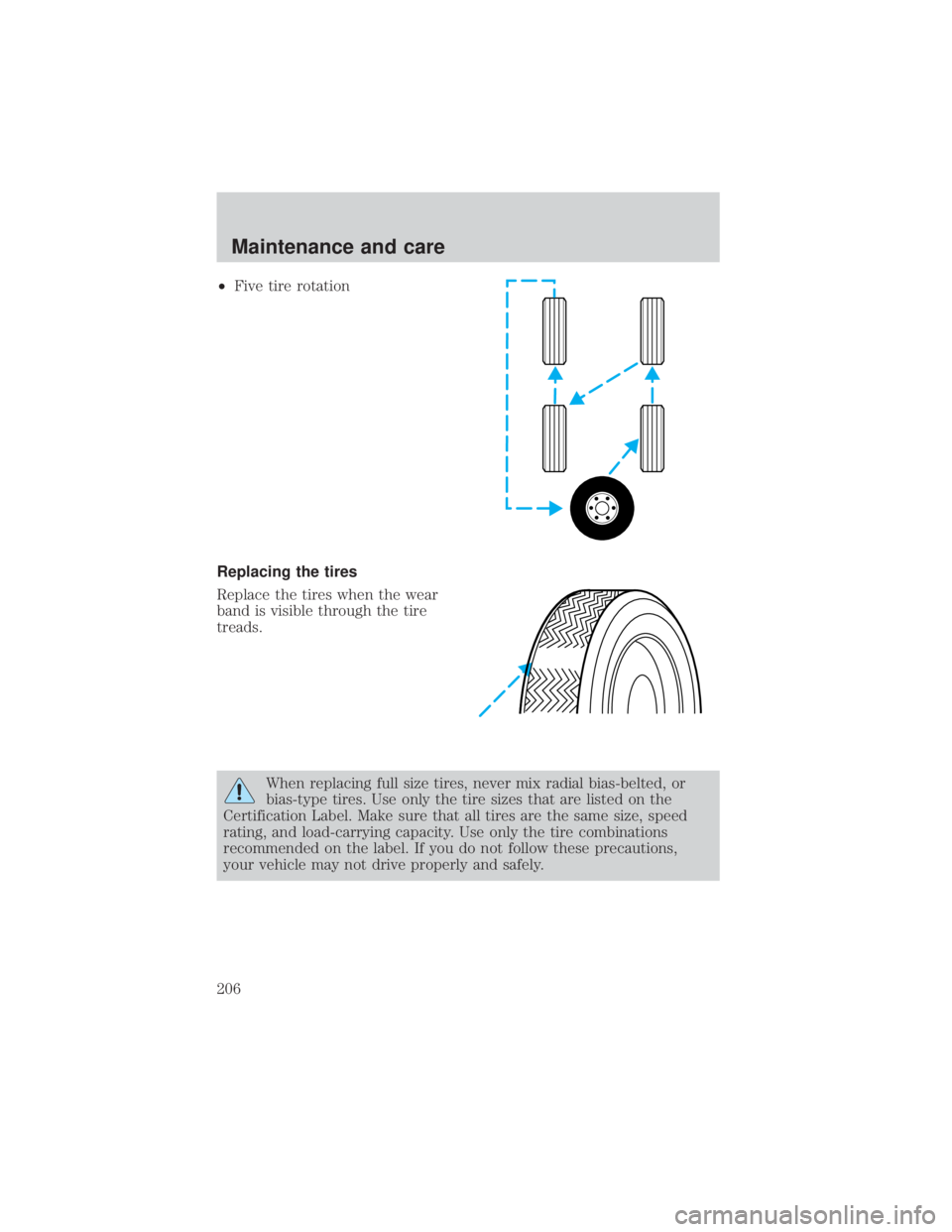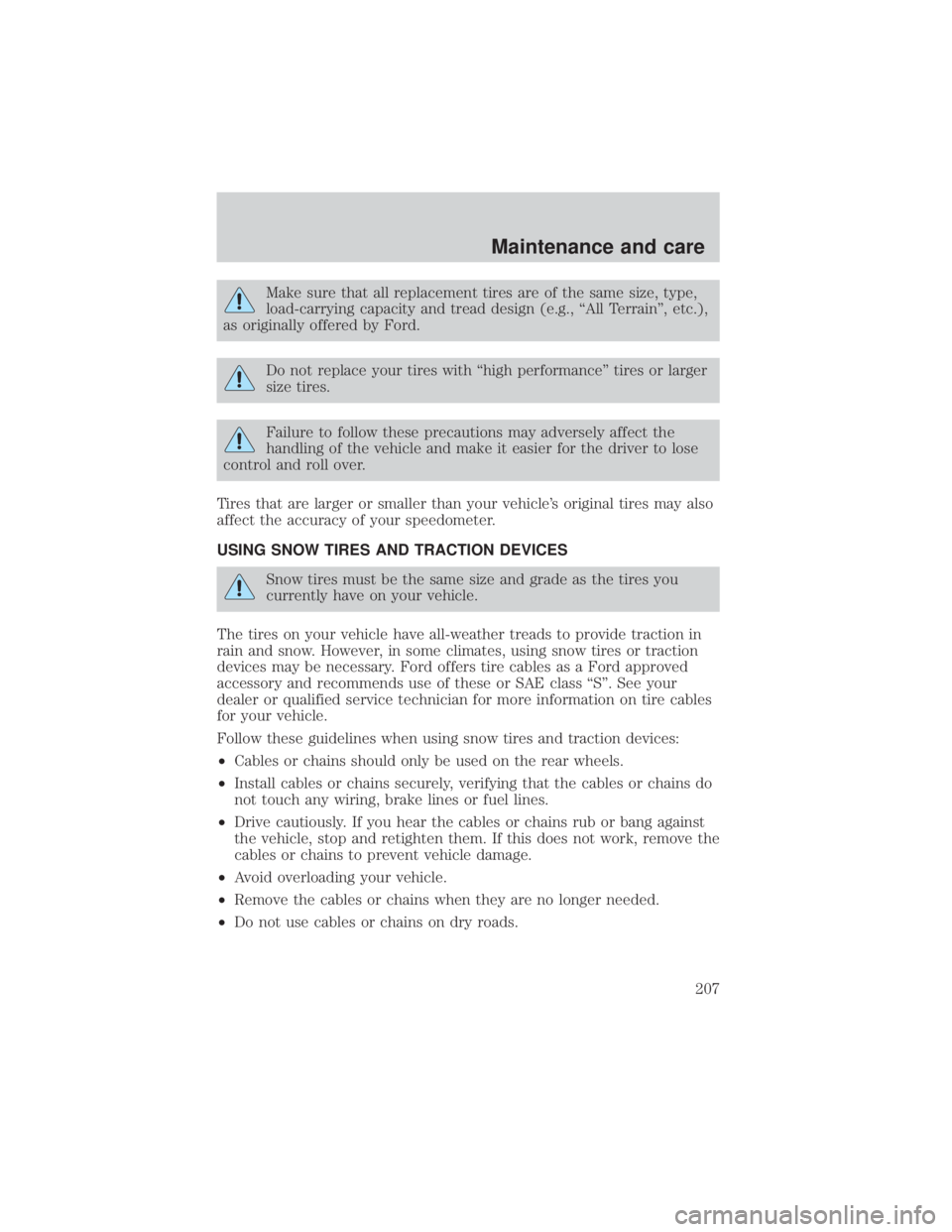2001 FORD EXPLORER SPORT TRAC load capacity
[x] Cancel search: load capacityPage 148 of 264

VEHICLE LOADING
Before loading a vehicle, familiarize yourself with the following terms:
²Base Curb Weight:Weight of the vehicle including any standard
equipment, fluids, lubricants, etc. It does not include occupants or
aftermarket equipment.
²Payload:Combined maximum allowable weight of cargo, occupants
and optional equipment. The payload equals the gross vehicle weight
rating minus base curb weight.
²GVW (Gross Vehicle Weight):Base curb weight plus payload
weight. The GVW is not a limit or a specification.
²GVWR (Gross Vehicle Weight Rating):Maximum permissable total
weight of the base vehicle, occupants, optional equipment and cargo.
The GVWR is specific to each vehicle and is listed on the Safety
Certification Label on the driver's door pillar.
²GAWR (Gross Axle Weight Rating):Carrying capacity for each axle
system. The GAWR is specific to each vehicle and is listed on the
Safety Certification Label on the driver's door pillar.
²GCW (Gross Combined Weight):The combined weight of the
towing vehicle (including occupants and cargo) and the loaded trailer.
²GCWR (Gross Combined Weight Rating):Maximum permissable
combined weight of towing vehicle (including occupants and cargo)
and the loaded trailer
²Maximum Trailer Weight Rating:Maximum weight of a trailer the
vehicle is permitted to tow. The maximum trailer weight rating is
determined by subtracting the vehicle curb weight for each
engine/transmission combination, any required option weight for trailer
towing and the weight of the driver from the GCWR for the towing
vehicle.
²Maximum Trailer Weight:Maximum weight of a trailer the loaded
vehicle (including occupants and cargo) is permitted to tow. It is
determined by subtracting the weight of the loaded trailer towing
vehicle from the GCWR for the towing vehicle.
²Trailer Weight Range:Specified weight range that the trailer must
fall within that ranges from zero to the maximum trailer weight rating.
Remember to figure in the tongue load of your loaded trailer when
figuring the total weight.
Driving
148
Page 149 of 264

Do not exceed the GVWR or the GAWR specified on the
certification label.
Do not use replacement tires with lower load carrying capacities than the
originals because they may lower the vehicle's GVWR and GAWR
limitations. Replacement tires with a higher limit than the originals do
not increase the GVWR and GAWR limitations.
The Safety Certification Label, found on the driver's door pillar, lists
several important vehicle weight rating limitations. Before adding any
additional equipment, refer to these limitations. If you are adding weight
to the front of your vehicle, (potentially including weight added to the
cab), the weight added should not exceed the front axle reserve capacity
(FARC). Additional frontal weight may be added to the front axle reserve
capacity provided you limit your payload in other ways (i.e. restrict the
number of occupants or amount of cargo carried).
Always ensure that the weight of occupants, cargo and equipment being
carried is within the weight limitations that have been established for
your vehicle including both gross vehicle weight and front and rear gross
axle weight rating limits. Under no circumstance should these limitations
be exceeded. Exceeding any vehicle weight rating limitation could result
in serious damage to the vehicle and/or personal injury.
Special loading instructions for owners of pickup trucks and
utility-type vehicles
For important information regarding safe operation of this type
of vehicle, see thePreparing to drive your vehiclesection
intheDrivingchapter of this owner guide.
Loaded vehicles, with a higher center of gravity, may handle
differently than unloaded vehicles. Extra precautions, such as
slower speeds and increased stopping distance, should be taken when
driving a heavily loaded vehicle.
Your vehicle has the capability to haul more cargo and people than most
passenger cars. Depending upon the type and placement of the load,
hauling cargo and people may raise the center of gravity of the vehicle.
Driving
149
Page 206 of 264

²Five tire rotation
Replacing the tires
Replace the tires when the wear
band is visible through the tire
treads.
When replacing full size tires, never mix radial bias-belted, or
bias-type tires. Use only the tire sizes that are listed on the
Certification Label. Make sure that all tires are the same size, speed
rating, and load-carrying capacity. Use only the tire combinations
recommended on the label. If you do not follow these precautions,
your vehicle may not drive properly and safely.
Maintenance and care
206
Page 207 of 264

Make sure that all replacement tires are of the same size, type,
load-carrying capacity and tread design (e.g., ªAll Terrainº, etc.),
as originally offered by Ford.
Do not replace your tires with ªhigh performanceº tires or larger
size tires.
Failure to follow these precautions may adversely affect the
handling of the vehicle and make it easier for the driver to lose
control and roll over.
Tires that are larger or smaller than your vehicle's original tires may also
affect the accuracy of your speedometer.
USING SNOW TIRES AND TRACTION DEVICES
Snow tires must be the same size and grade as the tires you
currently have on your vehicle.
The tires on your vehicle have all-weather treads to provide traction in
rain and snow. However, in some climates, using snow tires or traction
devices may be necessary. Ford offers tire cables as a Ford approved
accessory and recommends use of these or SAE class ªSº. See your
dealer or qualified service technician for more information on tire cables
for your vehicle.
Follow these guidelines when using snow tires and traction devices:
²Cables or chains should only be used on the rear wheels.
²Install cables or chains securely, verifying that the cables or chains do
not touch any wiring, brake lines or fuel lines.
²Drive cautiously. If you hear the cables or chains rub or bang against
the vehicle, stop and retighten them. If this does not work, remove the
cables or chains to prevent vehicle damage.
²Avoid overloading your vehicle.
²Remove the cables or chains when they are no longer needed.
²Do not use cables or chains on dry roads.
Maintenance and care
207
Page 256 of 264

lubrication
specifications ..................235, 238
refill capacities ........................233
service points ..........................184
starting after a collision .........159
Engine block heater .................130
Engine oil ..................................185
checking and adding ..............185
dipstick ....................................185
filter, specifications ........187, 233
recommendations ...................187
refill capacities ........................233
specifications ..................235, 238
Exhaust fumes ..........................131
F
Flexible Fuel Vehicle (FFV) ....208
Floor mats ...................................74
Fluid capacities .........................233
Foglamps .....................................18
Four-Wheel Drive
vehicles ................................12, 142
control trac ...............................27
description ..............................143
driving off road .......................145
electronic shift ..................27, 143
indicator light .........................143
preparing to drive your
vehicle .....................................135
Fuel ............................................208
calculating fuel economy .......215
cap .......................................9, 214
capacity ...................................233
choosing the right fuel ...........211
comparisons with EPA fuel
economy estimates .................218
detergent in fuel .....................213filling your vehicle
with fuel ..................208, 214±215
filter, specifications ........215, 233
fuel pump shut-off switch .....159
gauge .........................................17
improving fuel economy ........215
octane rating ...................211, 238
quality ......................................212
running out of fuel .................213
safety information relating to
automotive fuels .....................208
Fuses ..................................161±162
G
Garage door opener ....................63
Gas cap (see Fuel cap) ........9, 214
Gas mileage (see Fuel
economy) ...................................215
Gauges .........................................14
battery voltage gauge ...............16
engine coolant temperature
gauge .........................................15
engine oil pressure gauge ........16
fuel gauge ..................................17
odometer ...................................15
speedometer .............................14
tachometer ................................16
trip odometer ............................15
GAWR (Gross Axle Weight
Rating) .......................................148
calculating ...............................150
definition .................................148
driving with a heavy load ......148
location ....................................148
GVWR (Gross Vehicle Weight
Rating) .......................................148
calculating .......................148, 150
definition .................................148
Index
256
Page 258 of 264

high beam .................................11
overdrive off ..............................12
safety belt .................................10
speed control ............................60
turn signal indicator .................11
Load limits .................................148
GAWR ......................................148
GVWR ......................................148
trailer towing ..........................148
Loading instructions .................149
Locks
autolock .....................................91
childproof ..................................70
doors ..........................................69
Lubricant specifications ...235, 238
Lumbar support, seats ...............99
M
Manual transmission .................140
fluid capacities ........................233
lubricant specifications ..........238
reverse .....................................141
Mirrors
cleaning ...................................232
fold away ...................................71
side view mirrors (power) .......70
Moon roof ....................................64
Motorcraft parts ................215, 233
O
Octane rating ............................211
Odometer .....................................15
Oil (see Engine oil) ..................185
Overdrive .....................................62P
Panic alarm feature, remote
entry system ................................86
Parking brake ............................133
Parts (see Motorcraft parts) ....233
Power distribution box (see
Fuses) ........................................165
Power door locks ........................69
Power steering ..........................134
fluid, checking and adding ....196
fluid, refill capacity ................233
fluid, specifications .........235, 238
Preparing to drive
your vehicle ...............................135
R
Radio ............................................27
Relays ........................................161
Remote entry system ...........84, 86
illuminated entry ......................88
locking/unlocking doors .....85, 88
panic alarm ...............................86
replacement/additional
transmitters ...............................87
replacing the batteries .............86
S
Safety belts (see Safety
restraints) ....................13, 102±106
Safety defects, reporting ..........253
Safety restraints ................102±106
belt minder .............................108
cleaning the
safety belts ......................111, 231
extension assembly ................107
Index
258